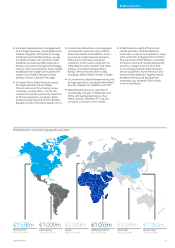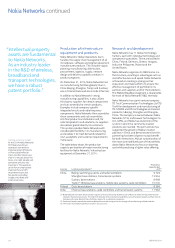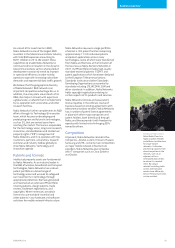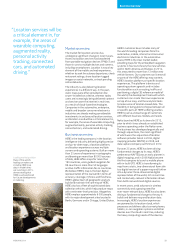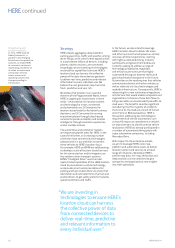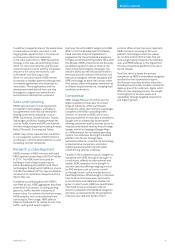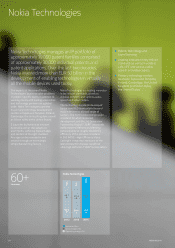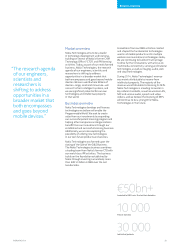Nokia 2014 Annual Report Download - page 27
Download and view the complete annual report
Please find page 27 of the 2014 Nokia annual report below. You can navigate through the pages in the report by either clicking on the pages listed below, or by using the keyword search tool below to find specific information within the annual report.
Business overview
25NOKIA IN 2014
As a result of its investments in R&D,
Nokia Networks is one of the largest R&D
investors in the telecommunications industry,
with total R&D expenses amounting to
EUR 1.8 billion in 2014. We expect these
capabilities to enable Nokia Networks to
continue to drive innovation in the dynamic
telecommunications sector, where product
development constantly needs to improve
in speed and eciency in order to help
operators cope with increasing subscriber
demands and exponential data trac growth.
We believe that the geographical diversity
of Nokia Networks’ R&D network is an
important competitive advantage for us. In
addition, the ecosystem around each of its
R&D sites helps it connect with experts on
aglobal scale, a network that it complements
by co-operation with universities and other
research facilities.
Nokia Networks further complements its R&D
eorts through its Technology & Innovation
team, which focuses on developing and
prototyping new and futuristic technologies,
such as 5G, that are several years from
reaching the market. The team is responsible
for the technology vision, long-term research,
innovation, standardization and intellectual
property rights (“IPR”) management of
Nokia Networks, and it co-operates with top
customers, partners, universities, research
institutes and industry bodies globally to
drive Nokia Networks’ technology and
innovation agenda.
Patents and licenses
Intellectual property assets are fundamental
to Nokia Networks. As an industry leader in
the R&D of wireless, broadband and transport
technologies, Nokia Networks has a robust
patent portfolio in a broad range of
technology areas and we seek to safeguard
our investments in technology through
appropriate protection. We have generated
and maintained an extensive IPR portfolio
covering patents, design patents, trade
secrets, trademark registrations, and
copyrights. Where necessary, we obtain
licenses to use standard-essential and
other patents in our hardware and software
solutions for mobile network infrastructure.
Nokia Networks now owns a large portfolio
of almost 4 000 patent families comprising
approximately 11 000 individual patents
and patent applications across many
technologies, some of which were transferred
from Nokia and Siemens at the formation of
the business as Nokia Siemens Networks in
2007. Its IPR portfolio includes high-quality
standard-essential patents (“SEPs”) and
patent applications which have been declared
to the European Telecommunications
Standards Institute and other Standards
Developing Organizations as essential to
standards including LTE, WCDMA, GSM and
other standards. In addition, Nokia Networks
holds copyright registrations relating to
certain aspects of its products and services.
Nokia Networks receives and pays patent
license royalties in the ordinary course of
business based on existing agreements with
telecommunications vendors. Nokia Networks
has a number of patent license agreements
in place with other major companies and
patent holders, both directly and through
Nokia, and these provide it with freedom to
operate with limited risk of infringing SEPs
owned by others.
Competition
At present, Nokia Networks considers ve
companies—Alcatel-Lucent, Ericsson, Huawei,
Samsung and ZTE—to be its main competitors
as major mobile network infrastructure
providers. Nokia Networks also competes
with IT companies such as Cisco Systems
andOracle.
Building a Radio Cloud
Nokia Radio Cloud is a
highly scalable, exible
and ecient architecture
for cloud-based
networks. It allocates
processing capacity from
almost anywhere in the
network, such as an
adjacent cell or a
centralized data center,
to where it is needed
most. By using a
network’s existing radio
access and transport
assets more eciently,
extra infrastructure costs
can be avoided.










